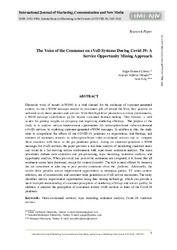The voice of the consumer on sVoD systems during covid-19: A service opportunity mining approach
| dc.contributor.author | Cadirci, T. O. | |
| dc.contributor.author | Gungor, A. S. | |
| dc.contributor.author | Kılıç, Sena | |
| dc.date.accessioned | 2023-09-11T11:13:04Z | |
| dc.date.available | 2023-09-11T11:13:04Z | |
| dc.date.issued | 2022-01 | |
| dc.identifier.issn | 2182-9306 | en_US |
| dc.identifier.uri | http://hdl.handle.net/10679/8785 | |
| dc.identifier.uri | http://u3isjournal.isvouga.pt/index.php/ijmcnm/article/view/528 | |
| dc.description.abstract | Electronic word of mouth (e-WOM) is a vital channel for the exchange of customer-generated content. As the e-WOM messages created by consumers pile all around the Web, they generate an unbiased voice about products and services. With their high-level production in online environments, e-WOM message contributions go far beyond consumer decision-making. They become a vital source for gaining insights on designing and improving marketing offerings. The purpose of the study is to analyze service improvement opportunities for subscription-based video-on-demand (sVoD) services by exploring customer-generated eWOM messages. In addition to this, the study aims to comprehend the effects of the COVID-19 pandemic on expectations, real feelings, and attitudes of customers towards its subscription-based video-on-demand services and to compare these emotions with those in the pre-pandemic period. Acting on customer-generated e-WOM messages for sVoD services, the paper provides a real-time analysis of monitoring customer needs and wants in a fast-moving service environment with topic-based sentiment analysis. The main procedures include data extraction and pre-processing, topic modeling, sentiment analysis, and opportunity analysis. When pre-covid and post-covid sentiments are compared, it is found that all sentiment scores have decreased, except for content diversity. The rich content offered by Amazon has led subscribers to take step to post positive comments about the platform. Addtionally, the results show possible service improvement opportunities in streaming quality, TV series content selection, use of commercials, and customer value generation in sVoD service encounters. The study identifies service improvement opportunities using data mining technology, which can provide a more in-depth understanding of consumer perceptions of marketing offerings and service quality. In addition, it analyzes the perceptions of consumers toward sVoD services in times of the Covid-19 pandemic. | en_US |
| dc.language.iso | eng | en_US |
| dc.publisher | Inst Superior Entre Douro & Vouga | en_US |
| dc.relation.ispartof | International Journal of Marketing, Communication and New Media | |
| dc.rights | Attribution-NonCommercial-ShareAlike 4.0 International | * |
| dc.rights | openAccess | |
| dc.rights.uri | http://creativecommons.org/licenses/by-nc-sa/4.0/ | * |
| dc.title | The voice of the consumer on sVoD systems during covid-19: A service opportunity mining approach | en_US |
| dc.type | Article | en_US |
| dc.description.version | Publisher version | en_US |
| dc.peerreviewed | yes | en_US |
| dc.publicationstatus | Published | en_US |
| dc.contributor.department | Özyeğin University | |
| dc.contributor.authorID | (ORCID 0000-0002-0423-0394 & YÖK ID 277452) Kılıç, Sena | |
| dc.contributor.ozuauthor | Kılıç, Sena | |
| dc.identifier.issue | 11 | en_US |
| dc.identifier.startpage | 5 | en_US |
| dc.identifier.endpage | 29 | en_US |
| dc.identifier.wos | WOS:000765444300001 | |
| dc.subject.keywords | Video-on-demand services | en_US |
| dc.subject.keywords | Topic modeling | en_US |
| dc.subject.keywords | Sentiment analysis | en_US |
| dc.subject.keywords | Covid-19 | en_US |
| dc.subject.keywords | Customer reviews | en_US |
| dc.relation.publicationcategory | Article - International Refereed Journal - Institutional Academic Staff |
Files in this item
This item appears in the following Collection(s)
Share this page




